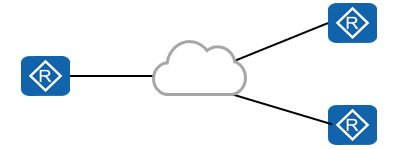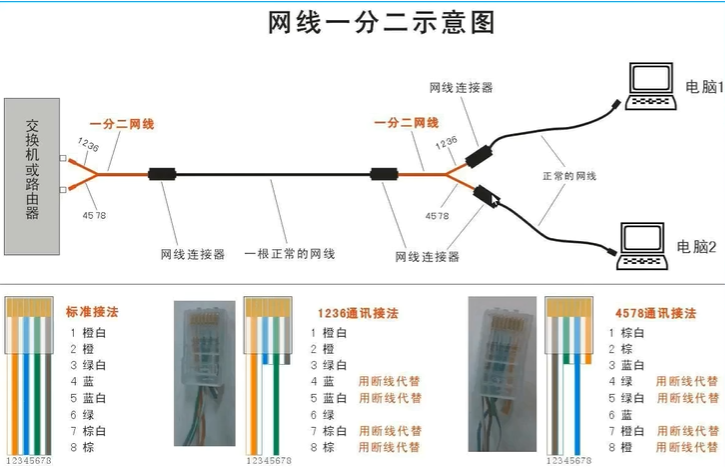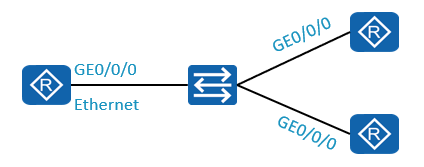- Ospf network type is a very important interface variable. This variable will affect the operation of OSPF on the interface, such as how to send OSPF protocol messages and whether to elect DR and BDR.
- OSPF has four network types: P2P, P2MP, BMA(Broadcast) and NBMA.
- Influence of ospf network type: generally, the OSPF interface network type at both ends of the link must be the same, otherwise the two sides cannot establish a neighbor relationship.
P2P (point to point)

- P2P refers to the environment where only two network devices can be connected on a link, one cable, one left and one right.
- In this environment, there are only 2 devices, or only 2 devices. Other devices cannot be added in the middle of the link. For example, switch equipment cannot be added to a link.
- A typical example is a PPP link. When the interface adopts PPP encapsulation, OSPF adopts P2P as the default network type on the interface.
P2mp (point Ti multi point to multipoint)

- P2MP is equivalent to a network obtained by bundling a section of multiple P2P links.
- No link layer protocol will be considered as P2MP network type by default. This type must be changed manually by other network types.
- The common practice is to change the non fully connected NBMA into a point to multipoint network.
P2MP example diagram

Ma, multi access, there are two types of multi access networks: Broadcast multi access network (BMA) and non broadcast multi access network (NBMA)
BMA(Broadcast Multiple Access)

- BMA, also known as Broadcast, refers to an environment that allows multiple devices to access and supports broadcasting.
- A typical example is Ethernet. When the interface is encapsulated by Ethernet, the default network type used by OSPF on the interface is BMA.
NBMA (non broadcast multiple access)

- NBMA refers to an environment that allows multiple network devices to access and does not support broadcasting.
- A typical example is a frame relay network.
The OSPF network type can be manually modified through commands under the interface to adapt to different network scenarios. For example, the BMA network type can be modified to P2P.
Example:

# After configuring the interface, the default is BMA [AR1-GigabitEthernet0/0/0]dis this [V200R003C00] # interface GigabitEthernet0/0/0 ip address 10.1.12.1 255.255.255.0 # return #View the network types that can be modified [AR1-GigabitEthernet0/0/0]ospf network-type ? broadcast Specify OSPF broadcast network nbma Specify OSPF NBMA network p2mp Specify OSPF point-to-multipoint network p2p Specify OSPF point-to-point network #Modify to P2P and re-establish neighbor relationship [AR1-GigabitEthernet0/0/0]ospf network-type p2p Feb 16 2022 21:54:50-08:00 AR1 %%01OSPF/3/NBR_CHG_DOWN(l)[8]:Neighbor event:neig hbor state changed to Down. (ProcessId=256, NeighborAddress=2.2.2.2, NeighborEve nt=KillNbr, NeighborPreviousState=Full, NeighborCurrentState=Down) [AR1-GigabitEthernet0/0/0] [AR1-GigabitEthernet0/0/0] Feb 16 2022 21:54:50-08:00 AR1 %%01OSPF/3/NBR_DOWN_REASON(l)[9]:Neighbor state l eaves full or changed to Down. (ProcessId=256, NeighborRouterId=2.2.2.2, Neighbo rAreaId=0, NeighborInterface=GigabitEthernet0/0/0,NeighborDownImmediate reason=N eighbor Down Due to Kill Neighbor, NeighborDownPrimeReason=Interface Parameter M ismatch, NeighborChangeTime=2022-02-16 21:54:50-08:00) [AR1-GigabitEthernet0/0/0] Feb 16 2022 21:54:56-08:00 AR1 %%01OSPF/4/NBR_CHANGE_E(l)[10]:Neighbor changes e vent: neighbor status changed. (ProcessId=256, NeighborAddress=2.12.1.10, Neighb orEvent=HelloReceived, NeighborPreviousState=Down, NeighborCurrentState=Init) [AR1-GigabitEthernet0/0/0] Feb 16 2022 21:54:56-08:00 AR1 %%01OSPF/4/NBR_CHANGE_E(l)[11]:Neighbor changes e vent: neighbor status changed. (ProcessId=256, NeighborAddress=2.12.1.10, Neighb orEvent=2WayReceived, NeighborPreviousState=Init, NeighborCurrentState=ExStart) [AR1-GigabitEthernet0/0/0] Feb 16 2022 21:54:56-08:00 AR1 %%01OSPF/4/NBR_CHANGE_E(l)[12]:Neighbor changes e vent: neighbor status changed. (ProcessId=256, NeighborAddress=2.12.1.10, Neighb orEvent=NegotiationDone, NeighborPreviousState=ExStart, NeighborCurrentState=Exc hange) [AR1-GigabitEthernet0/0/0] Feb 16 2022 21:54:56-08:00 AR1 %%01OSPF/4/NBR_CHANGE_E(l)[13]:Neighbor changes e vent: neighbor status changed. (ProcessId=256, NeighborAddress=2.12.1.10, Neighb orEvent=ExchangeDone, NeighborPreviousState=Exchange, NeighborCurrentState=Loadi ng) [AR1-GigabitEthernet0/0/0] Feb 16 2022 21:54:56-08:00 AR1 %%01OSPF/4/NBR_CHANGE_E(l)[14]:Neighbor changes e vent: neighbor status changed. (ProcessId=256, NeighborAddress=2.12.1.10, Neighb orEvent=LoadingDone, NeighborPreviousState=Loading, NeighborCurrentState=Full)